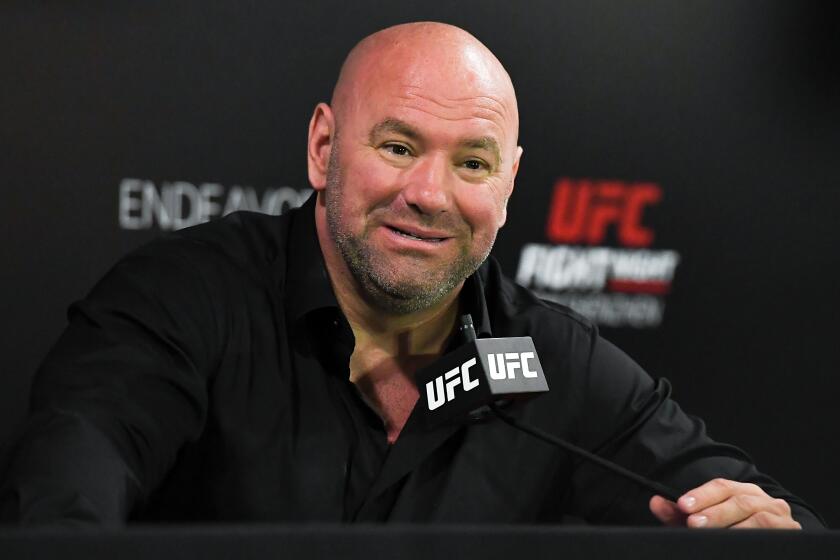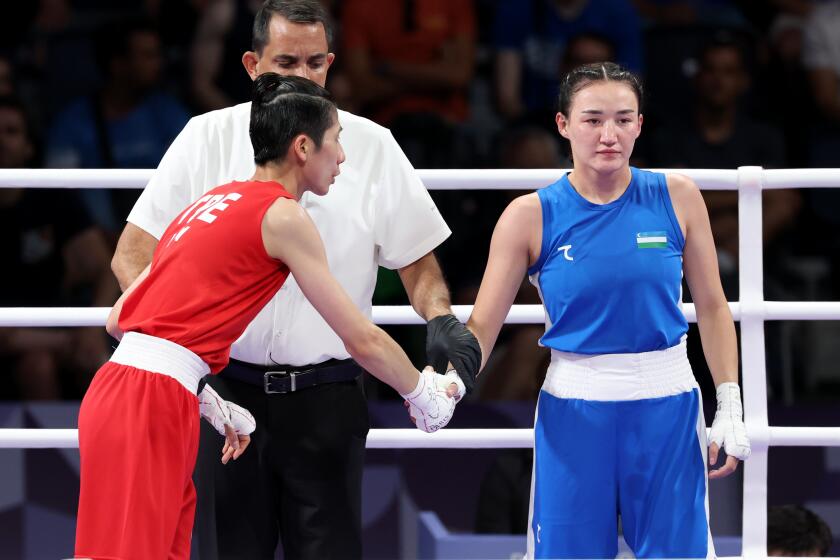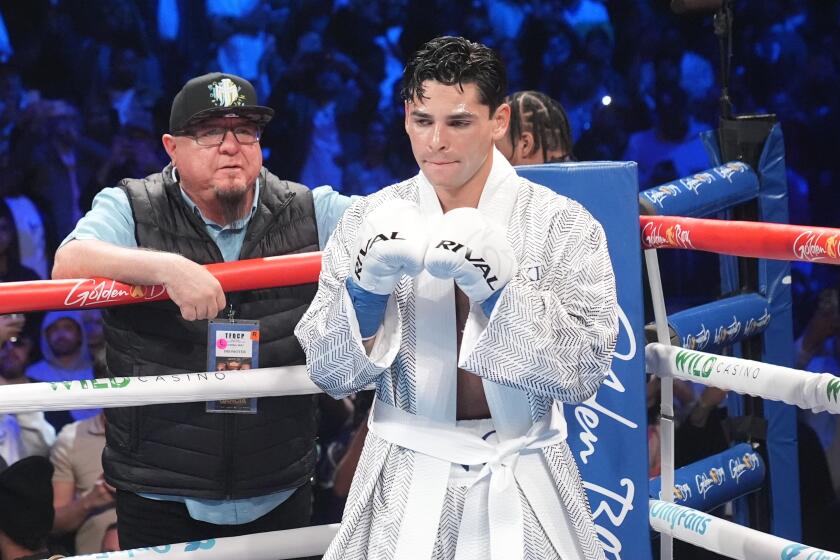MATCH-ISMO TV
LAS VEGAS -- It’s tough to watch featherweight Brian Ramirez facing one of the biggest challenges of his 21 years. He clutches his hands together, takes deep breaths and closes his eyes, as if to steel himself for what he’s about to do.
But it’s not a championship fight he’s facing. It’s the taping of an endorsement for the sponsor of a new reality TV show, “Retador Azteca,” or “Aztec Challenger,” that pits teams of Latino boxers from both sides of the border against each other. Ramirez, a Mexican American from El Monte, sits at the edge of a leather-and-suede sofa donated by a furniture company and reads from a short pitch written on a sign board.
“My name is Brian,” he says in Spanish as the camera rolls. “I want to tell you that every challenge means hard work and effort but, in the end, it has its rewards.”
Soon he fumbles over a word. Cut! He tries again, but flubs another phrase. He buries his face in his hands and leans over to hide his head between his knees. Nearby, his fellow Aztec challengers aren’t helping matters with their chatter.
“Listen, I’m going to kill you guys!” says producer Mapi Montero. “Be quiet or go back to your rooms.”
Instant silence. The pugilists know better than to mess with Montero, a cross between director, trainer, den mother and Nurse Ratched. “To be on this reality show you have to be a real man,” she tells me later. “It means you have to submit 24 hours a day, seven days a week to the command of a woman.”
Montero, an independent producer born in Chile and based in New Jersey, adapted the show concept from the 2005 NBC series “The Contender,” but with an international twist.
In “Retador Azteca,” which airs Sundays at 8 p.m. on the Azteca America network (Channel 54), one team is composed of Latinos from the United States, either immigrants or their offspring from Mexico and Puerto Rico. Based in Las Vegas for the show, they were recruited from gymnasiums and boxing centers across the country. The other is made up of boxers from throughout Mexico and now based in Puebla. Each team is spending four months together, competing in a series of elimination matches during the series, hosted by the Mexican boxer Jorge “El Travieso” Arce.
Winners from each team will compete for the $50,000 grand prize in a final match to be held May 18 at Caesars Palace. Before the showdown, the contestants will meet at the border between Tijuana and San Diego to make a symbolic crossing on foot, representing the ties between immigrants and their country of origin. (Knockoffs of English-language reality TV are plentiful in Mexico.)
In real life, there’s plenty of tension between Mexicans and their brethren raised across the border. The Mexicans call the Americans pochos and look down on them for being Anglicized and not speaking proper Spanish, like some of the boxers on the U.S. team. (One even mispronounces “Messico.”) Believe me, if they all lived together, there’d be a lot more conflict on this show.
But the point is not to pit one group of Latinos against the other, like that loaded season of “Survivor” that set up groups based on race and ethnicity. The Mexican series is meant to show solidarity between Latinos in the face of anti-immigrant bashing. “Sports is apolitical and color-blind,” says Montero.
The show also gives a twist to the usual Darwinian cruelty of reality TV. In this series, the losers are not humiliated, banished and sent home. Instead, they stay on and support their team’s champion. All 16 participants will be on hand for the border ceremonies and the final match.
“In reality shows, you leave and they forget about you,” says Montero. “But why? This is television. We make dreams come true.”
The story of the street-hardened boxer who overcomes hardships on the road to victory is a cliche. But it’s still compelling. Appropriately, the ring used for the U.S. team was the same one used by Sylvester Stallone in the last installment of his “Rocky” franchise. Montero says she bought it for a song, along with punching bags and other equipment, from the 1st Street Boxing Gym in Boyle Heights. The ring is part of the bare-bones set inside a Las Vegas warehouse. The location was previously used for storage by a neighboring strip club, which operates round the clock. On the day I visited, the boxers were stripping to their shorts to be weighed in while a stripper was doing her act for a handful of early afternoon patrons next door.
The Azteca boxers sleep in metal-frame bunk beds in an improvised loft above the warehouse. The only home-style touch is a 20-foot-tall mural of the Virgin of Guadalupe overlooking the ring, perhaps to keep the men’s minds off the action next door. Their protective producer, a mother of two, keeps them on a short leash.
There’s Ramirez, the “gentleman boxer” from El Monte, who finally completed filming his spot. Adam Gonzalez, 29, of Long Beach, who’s respectful and disciplined. Jose Hernandez, 25, of Atlanta, nicknamed “El Papi Zurdo” (The Lefty Loverboy), an expectant father with an enormous appetite. Johnny Narvaez, 21, of Miami, a charmer with good manners. Miguel Albares, 27, of Colorado Springs, the quiet and studious one. Eleazar Renteria, 22, of Houston, who took to boxing at 5. Isaac Suarez, 20, of San Juan, Puerto Rico, good-tempered and always smiling despite being raised in the school of hard knocks. And finally Angel Torres, 23, of Yonkers, N.Y., the “little devil with the heart of gold.”
You can’t help but notice Torres, with his custom-made shorts emblazoned with the U.S flag on one leg and the Puerto Rican flag on the other, stripes flapping like tassels down his thigh. His showmanship masks a troubled life.
Torres told me that his farther died before he was born and his mother was later jailed on drug charges. Raised by aunts and uncles and bounced from house to house, the self-described “angry young kid” was always getting into street fights, where he’s been shot and stabbed. Later, reunited with his mother, she encouraged him to get into boxing, saying, “You might as well stop getting in trouble and get paid instead.” Now, she’s seriously ill and he hopes to help her with the prize money.
The young man wears his optimism on his arms in the form of tattoos. On one side, there’s a large portrait of Jesus with boxing gloves dangling from a rosary and the slogan “My time to shine.” On the other, there’s barely room on his forearm for these words to live by: “Judge one not by his past but by his future. Not by where he’s been but where he’s going. Not by what he’s done but what he can achieve.”
--
More to Read
Go beyond the scoreboard
Get the latest on L.A.'s teams in the daily Sports Report newsletter.
You may occasionally receive promotional content from the Los Angeles Times.










